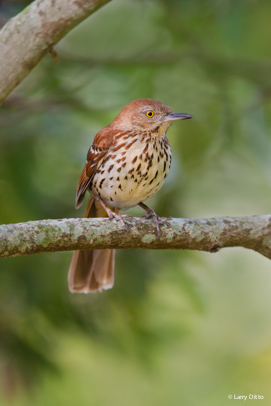
Wild Thing: Thrashing Mimic
The aptly named brown thrasher stirs up leaf litter for dinner and does impressions.
By Cliff Shackelford
A lot of bird names don’t make sense to me. We use some names to describe human characteristics: he’s a “loon,” a “sapsucker” or a little “cuckoo.”
The brown thrasher’s name, however, makes perfect sense. The bird is mostly rusty-brown and thrashes around in the brush or leaf litter looking for insects, seeds, fruits and other food items — just like a yard hen.
Deer and duck hunters out before sunrise often hear brown thrashers, one of the first songbirds to vocalize before sunrise. They emit a loud sound that resembles air being let out of a tire tube (as in pffiitt). This bird’s repertoire also includes another call-note — a soft whistle reminiscent of a slow laser gun from a sci-fi movie (drzzzttt).
Eight species of thrashers occur in the U.S., but the brown thrasher dominates in more than half of Texas. The species is completely absent from the Trans-Pecos and, in deep South Texas, is replaced by its look-alike cousin, the long-billed thrasher. Some brown thrashers, especially in urban areas, are year-round residents in Texas. Individuals found in more rural areas tend to be winter residents that breed farther to our north and retreat here during the colder months. The big push of thrashers to Texas happens in late September through early October.

Thrashers are in the same family as our state bird, the northern mockingbird. Both are excellent mimics, which means they imitate sounds around them, not just birdsong. A squeaky gate and car alarm are some of the sounds heard emanating from these birds. The thrasher replays imitations in duplicate, while the mockingbird does so in triplicate (or more).
Brown thrashers prefer thickets, brush piles, woody fencerows and dense shrubs. In urban areas, they often tiptoe out onto the edges of a mowed lawn, but will quickly retreat to dense thickets when spooked or startled. To me, this bird has severe stage fright and would rather skulk in the dark shadows under bushes.
We have brown thrashers in our backyard year-round in East Texas; they’re one of my favorite yard birds to hear and watch. They enjoy our backyard birdbath, “thrashing around,” flicking water all over the place. See if you can find a brown thrasher in your yard or on your property.
Common Name Scientific Name Habitat Diet Did you know? |
Related stories
See more wildlife articles on TP&W magazine's Texas wildlife page

